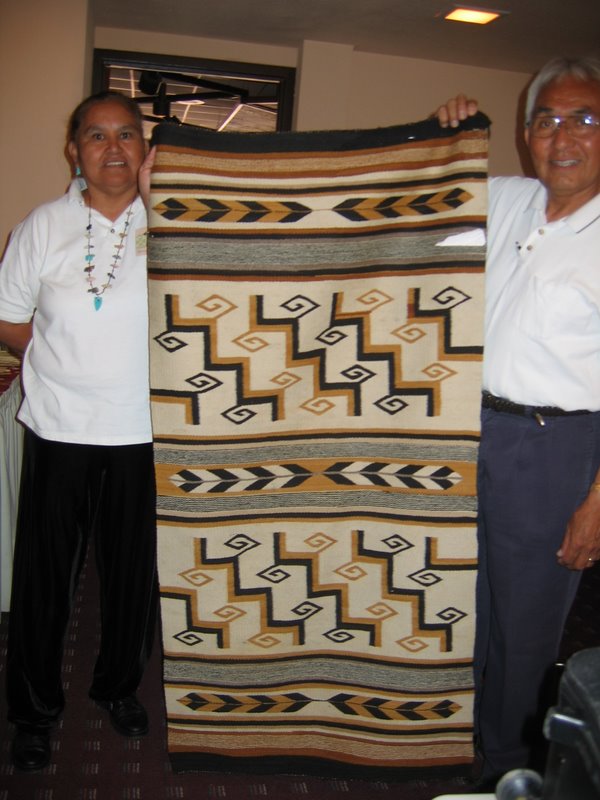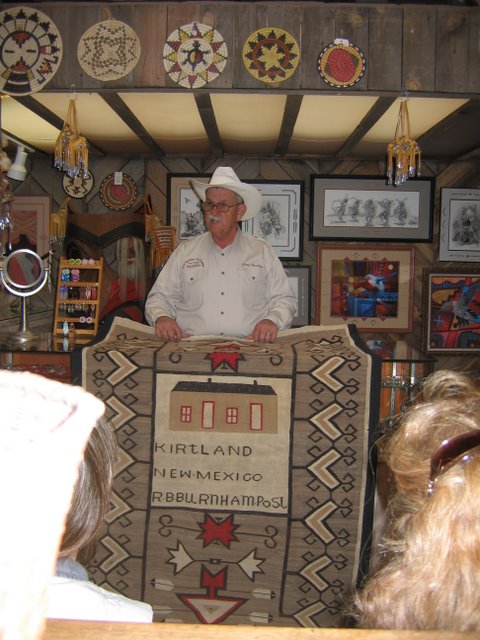Rare Weaves: The Bisti Rug
In an earlier post, I made a reference to the Bisti area and received a question about the characteristics and history of the Bisti style of weaving. Many people have never heard of a Bisti rug and if they’ve seen one, they may not have recognized it. The name Bisti comes from the region where the rugs were woven and refers to an area that runs south from Farmington, New Mexico towards Chaco Canyon and Crownpoint, New Mexico. The western boundary is probably highway 491. Bisti meands badlands in Navajo, and when the Navajos call something a badland, they’re not kidding around. To get an idea of the look of the area, check this article from the Desert USA web site. Although it is not an easy area to live in, there are some Navajo people who make their homes there and the weavers have developed two related weaving styles, namely the Bisti rug and the Burnham rug, which developed later.
I think that there are two main features that identify a Bisti rug; the design geometry and the presence of yarn dyed with wild carrrot, with the geometry being the most important identifier and the dyestuff helping to fix the location. The hall mark of the design is a complex of ordered and connected keyed structures. Often, but not always, prayer feathers and other pictorial motifs are used as design elements. One of the best Bisti examples I’ve seen is a rug that I repaired last year. You can see it below being held by Jennie Slick (left) and Milt Shirlson (right).
This rug also shows the other hallmark of Bisti weaving, wool dyed with wild carrot. Wild carrot or canyaigre is a form of rumex or dock root that grows in areas of the Navajo Nation that have sandy soil. In some areas around Bisti, wild carrot is one of the few plants that can be used to yield a natural colorant for wool In fact, it is one of the most stable of all the natural dyes used by the Navajos and I’ll post more on it toward the end of next week. Aniline red dyes were also often used in Bisti weavings, but that and wild carrot are usually the only two dyed colors present in a Bisti rug.
The rug above was woven toward the end of the most active period of the Bisti style, sometime in the 1940’s or 1950’s. The earliest examples of the style go back to the early 1900’s, when Navajo textiles were in the transition from blankets to rugs. These early rugs were tradied mainly to the Burnham family at the Bisti and Burnham trading posts, but some were probably traded in Shiprock and Farmington and many went into homes in Durango, Pagosa Springs and other areas in southern Colorado.
I have seen Bisti style rugs referred to as variants of Teec Nos Pos rugs, and the two areas are relatively close to each other geographically. A bordered Bisti rug can look similar to a Teec Nos Pos in terms of design density (the amount of design versus open space), but does not share the same design motifs or geometry. As the Bisti design developed, the use of geometric elements increased and the distinct pictorial style that is referred as a Burnham rug emerged. An early example that’s right on the cusp between the two styles is seen below. It’s owned by trader Buce Burnham and was woven for his grandfather.  I’m not aware of any weavers doing a distinct Bisti style today, but Burnham rugs are being woven by the Begay/Barber family and other weavers both in the Bisti area and in other locations. The Crownpoint Rug Auction is one of the best places to see these descendents of the Bisti Style.
I’m not aware of any weavers doing a distinct Bisti style today, but Burnham rugs are being woven by the Begay/Barber family and other weavers both in the Bisti area and in other locations. The Crownpoint Rug Auction is one of the best places to see these descendents of the Bisti Style.

Your blog is interesting!
Keep up the good work!
I found your site on technorati and read a few of your other posts. Keep up the good work. I just added your RSS feed to my Google News Reader. Looking forward to reading more from you down the road!